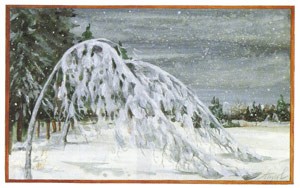
When I see birches bend to left and right
Across the lines of straighter darker trees,
I like to think some boy's been swinging them.
-Robert Frost, "Birches"
Thanks to Robert Frost, when you see a birch bent to the ground, it’s almost impossible not to imagine a boy climbing it, hand over hand, until the stem reaches its limit and the treetop and the wildly kicking boy swoop to earth.
You might also imagine that it’s a paper birch – the beauty queen of the birch family – being swung. But gray birch – more like the scullery maid of the family – is much more suitable for swinging. Its slender trunks are amazingly pliable.
Last winter, heavy snow brought the tops of a clump of four gray birches outside our kitchen window all the way down. More snow fell, and then it warmed up enough to melt the surface, which soon froze to a crisp. The birch tops were locked in for weeks, and I was half inclined to put them out of their misery. That would have been a mistake. Upon thawing, they rose carefully, just a little each day, like prudent invalids regaining their feet. Recovery was complete, and no symptoms were to be seen by the time they leafed out in May.
Like many of their fellows, those four gray birches are thriving on what most other trees would find to be an inhospitable site, in this case on partially excavated, acidic, southwest-facing, sandy soils. An old name for gray birch is “poverty birch,” for its ability to colonize places even worse than mine (totally depleted soil and mine tailings) or to grow “in no soil at all,” as one writer has noted.
The species is short-lived – it’s a lucky gray birch that celebrates its 50th birthday – and for this reason it is often rejected by the nursery trade. Considering how often landscape trees outgrow their appointed place in the garden, perhaps this tree’s planned obsolescence should instead be considered a virtue. Also desirable from a nurseryman’s point of view is that gray birch is not as susceptible to the bronze birch borer, a major killer of several other kinds of birch, made worse when a tree is transplanted or otherwise stressed.
It is often pointed out that paper birches are brighter and whiter, but gray birches have a more delicate beauty. The central stem does not branch, and many slender, short, lateral branches, no bigger in diameter than your finger, cover the tree from the top nearly to ground level. They are not shed as the tree grows. This diaphanous, bushy appearance is heightened when the leaves flutter, as they do in the slightest breeze. The triangular leaves are doubly toothed and have long-pointed tips and a glistening, dark green upper surface.
In winter, 2-inch-long, brown male catkins are visible at the ends of the twigs. These double in length in spring. The female flower is green and appears with the unfolding of the leaves. The seeds that form ripen in October and are dispersed over several months. The seeds are tiny and light and are often blown such a great distance from the parent tree that the source of the seed seems mysterious. Long ago, when thickets of gray birch sprang up in abandoned fields or burnt-over land, some people thought that the tree had managed to reproduce spontaneously – without any seeds.
The seeds are eaten by many species of small songbirds, including goldfinches, pine siskins, and chickadees. Ruffed grouse eat the buds and male catkins; deer, snowshoe hare, and moose feed on the twigs in winter; beavers and porcupines favor the bark. Gray birches provide cover for bobcat and hare.
Gray birch is often considered to be a weed, being useless as a timber tree. And perhaps the fact that it grows contentedly on sites that are unsuitable for most other trees inclines us to consider it as a form of lowlife – a tree with no standards. Yet, by adding organic matter and shade to parched and starved soils, it allows larger, longer-lived trees to become established where they otherwise would not survive. Then, very obligingly, it dies.
One could do worse than be a gray birch.

